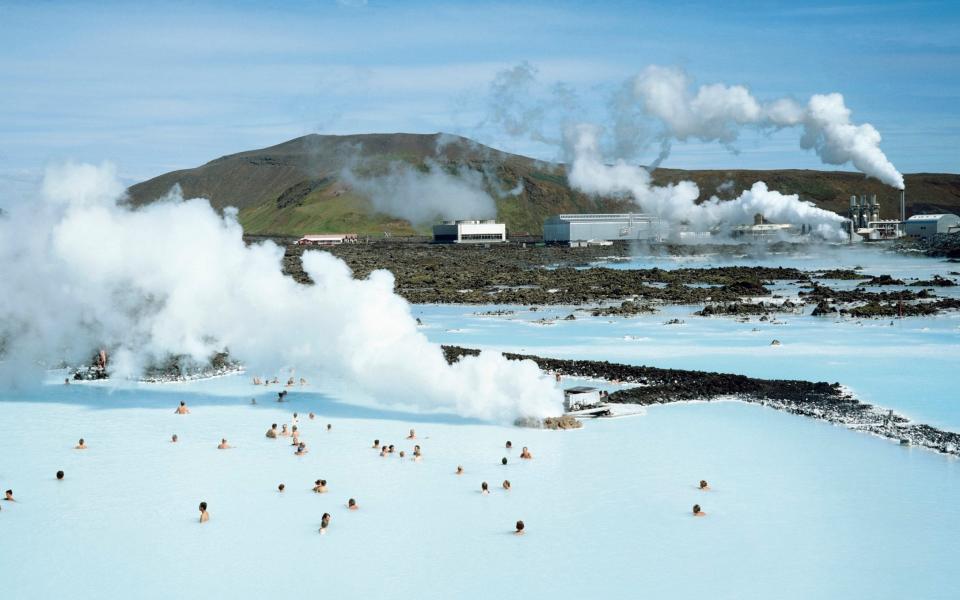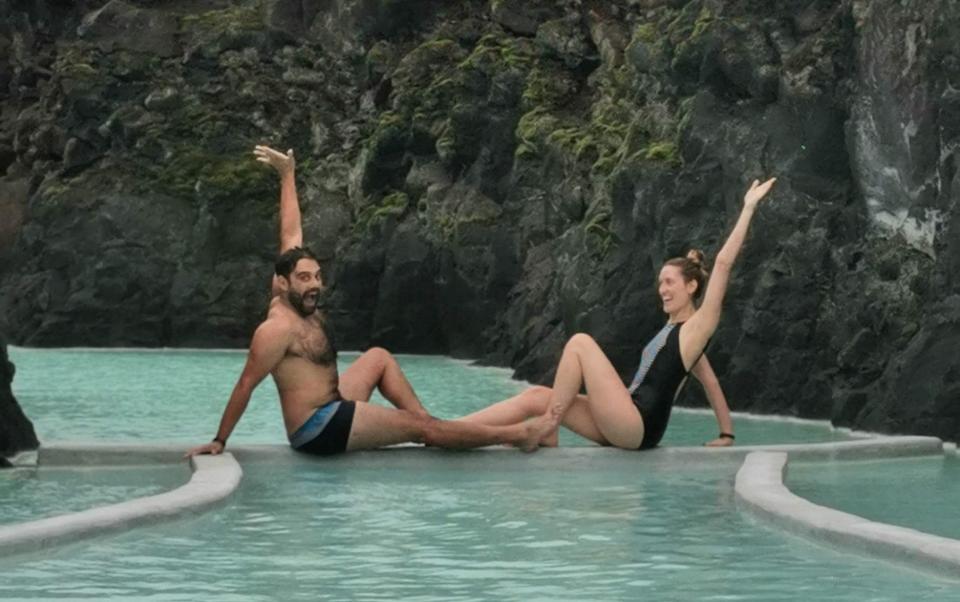How one man's 1981 swim changed the history of Iceland

I slathered myself in the white silica mud, which collects at the bottom of the pool, before wading through Iceland’s iconic Blue Lagoon. As I slunk into the silky bathbomb-like water, I took in the otherworldly landscape of green moss, black lava fields offset by the eponymous blue. The place was busy with Icelanders drinking beer, and tourists snapping selfies, but there was plenty of space to quietly float around in the misty air.
It was a Svartsengi geothermal power plant worker who discovered the appeal of these sulphuric waters. In 1981, he took a dip in the turquoise pools, pumped from deep beneath the Reykjanes Peninsula, in the hope that the mineral-rich mud would reduce the symptoms of his psoriasis – it worked. Word quickly spread about the enchanting reservoir and locals began to visit. A decade later, in 1992, a doctor from Reykjavik named Grimur Saemundsen founded Blue Lagoon Limited to formalise access and create skin products – a world-wide phenomenon was born.
During my visit, one of Blue Lagoon’s lifeguards told me that at night, she sometimes sees a red glow beyond the ridge behind the power plant. It was a clue to the source of all the heat, and the key to Icelandic tourism. Vulcanism.
Iceland sits on the Mid-Atlantic Ridge, where geological forces push the Earth’s tectonic plates apart. At Iceland, magma rises to the surface and bursts through the Earth’s crust to form volcanoes. Most of the world discovered this in April 2010, when ash from the Eyjafjallajokull eruption disrupted air travel in Europe and North America for a month.
“That was when tourism started booming,” said Clive Stacey, co-founder of Discover the World, which specialises in bespoke trips to Iceland. “We had been running eruption tours since 1986, but Eyjafjallajokull made everyone aware that they could go and see one. It coincided with the growth of Instagram, where people were posting insanely surreal pictures of landscapes, mostly within a day-trip from Reykjavik.”
Iceland’s tourism industry grew alongside the fame of Blue Lagoon to become a powerhouse. In 2019, the year before the pandemic, more than two million international visitors travelled to Iceland and more than half of them visited the Blue Lagoon. “To some people, it’s the best place in Iceland,” said Stacey, “to others it’s too commercial. Either way, the Blue Lagoon fascinates people, and it played a big part in developing modern Icelandic tourism.”

The golden circle
To experience the rest of the country’s wonders and geothermal activity I planned to visit the Golden Circle, a 186-mile route from the capital that takes in three of Iceland’s most popular attractions – Thingvellir, a giant rift valley formed in the middle of two tectonic plates; the mighty Gullfoss waterfall, spewing more than 100,000 litres per second; and the Haukadalur Geothermal Area, filled with mud pot geysers shooting water some 30 metres into the air.
I planned to see them all, but then one of Iceland’s worst storms in decades blew in, and government warnings advised us to “Stay in Place”. I enjoyed an extra night in the capital, and it was a reminder that you need to be flexible when travelling due to Iceland’s changeable weather.
I spent the day at Perlan, an interactive science museum in the city centre, which features an actual ice tunnel, and a poignant exhibition about Iceland’s glaciers. Climate change is happening right in front of Icelandic eyes, and in 2014, Okjokull became the first Icelandic glacier to “die”. At current rates, most of Iceland’s glaciers will be gone by 2100, even Vatnajokull, which covers eight per cent of the country.
Iceland generates all of its energy from renewable sources, but there’s no getting away from the need to fly there. Tour operators are switching to less carbon intensive operations, such as electric boats for whale-watching, and Iceland is a good short-haul choice to avoid flying around the globe for natural wonders. Staying for longer reduces flight frequency, and the country will keep you busy for weeks.
When the storm finally cleared, I drove out to Thingvellir. The vast cliff that runs below the visitor centre actually marks the edge of the North American plate, but Thingvellir has cultural significance, too: it was the site of the Alþingi, Iceland’s first parliament, which was founded in AD 930, and the country’s early settlers would travel here every year to debate laws and policy.
Myths and legends
“Narratives connect visitors to a place,” said Gunnar Thor Johannesson, a professor of tourism at the University of Iceland. “Icelanders have begun to understand that tourists are interested in our stories and legends, and will travel to hear them: the Museum of Icelandic Sorcery and Witchcraft is in the Westfjords, and the immersive 1238 Battle of Iceland exhibition in Sauoarkrokur is on the north coast. It gives visitors a reason to go there beyond the natural beauty.
“Films and TV help, too. People see these amazing landscapes, and it connects them, subconsciously, to the legend of the place. Fans want to see where Game of Thrones and Star Wars were filmed, and it takes them to some remote spots.”
I reached Haukadalur by late afternoon, as the car park emptied of coaches. This hot spring of bubbling mud pits and exploding geysers is powered by tectonic contortions deep in the Earth, throwing jets of boiling water hundreds of feet in the air. Nearby Gullfoss sends up spray that catches the setting sunlight, recasting it as a rainbow and giving rise to its name (Gold Falls). Both sites were quiet enough to enjoy at my own pace, but at the height of summer, the crowds can be vast.
“The simplest thing to do is to travel outside of June, July and August,” Stacey said. “But, if you must go in summer, then visit these sites late at night – it’s still light, and they are particularly beautiful at that time of day.”

“Icelandic over-tourism is a bit of a misnomer,” explained Gunnar. “Yes, the south and southwest gets crowded in summer. But the rest of the country is still pretty empty and spectacular; just less accessible from Reykjavik. Creating the Diamond Circle and Arctic Coast Way from Akureyri gave visitors confidence and information about travelling to these regions, and the infrastructure is improving, too.”
Rather than returning to Reykjavik, I spent the night at Hotel Ranga. Driving towards the hotel, I saw what I thought was a cloud running along the horizon, and it took me a few minutes to figure out that I was actually looking at the edge of the Eyjafjallajokull glacier.
The cool air of the glacier creates a weather window of reduced cloud over Ranga, which meant that, as darkness fell, a shimmering veil of green light waved over the sky from the north. Iceland sits right beneath the point that charged particles from the Sun crash into Earth’s upper atmosphere, creating the Northern Lights. If you get clear weather, and the sky is dark enough, you are almost guaranteed to see them.
As I drove to Keflavik Airport, I swung by the Blue Lagoon for a final dip. Despite its popularity, it is a true home-grown use of the island’s natural resources, and the perfect introduction to what makes Iceland special.
How to do it
Discover the World (01737 214291; discover-the-world.com) offers a five-night Iceland self-drive based on three nights at Hotel Ranga B&B, two nights in Reykjavik B&B and a hire car from £806. Blue Lagoon entry is from £57 per person; an additional night at the Retreat at Blue Lagoon with an extra day’s car hire costs from £773 per person.

 money
money 